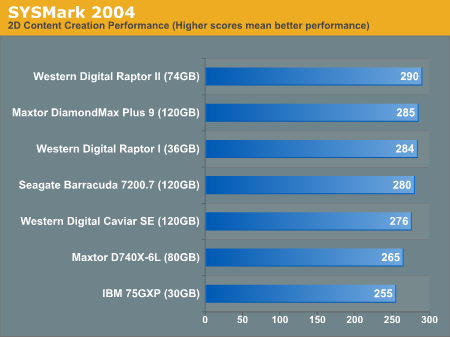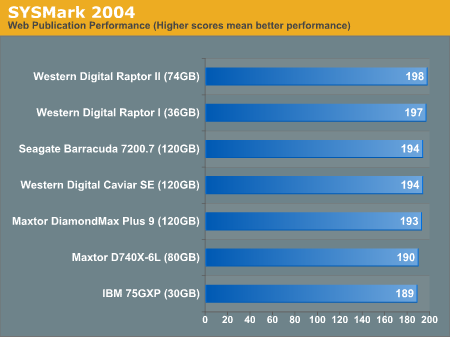Q2 2004 Desktop Hard Drive Comparison: WD Raptor vs the World
by Anand Lal Shimpi on June 7, 2004 12:05 AM EST- Posted in
- Storage
Overall System Performance - SYSMark
SYSMark 2004 is divided into two separate suites: Internet Content Creation and Office Productivity. What makes SYSMark an ideal hard disk benchmark is that its scores are totals of response times, meaning that the benchmark measures how long the system takes to respond to a task (e.g. how long before a search and replace is completed after it is initiated) and sums up all such response times to generate a score. This score is generated for six total subcategories, three under Internet Content Creation and three under Office Productivity.
For the most part, SYSMark is CPU/platform bound, but we will see some variations in performance according to disk speed; at the same time, there are a couple of benchmarks within SYSMark that are heavily disk dependent.
First, we start with Internet Content Creation performance; the first category that we will deal with is 3D Content Creation. The tests that make up this benchmark are described below:
"The user renders a 3D model to a bitmap using 3ds max 5.1, while preparing web pages in Dreamweaver MX. Then the user renders a 3D animation in a vector graphics format."

Generally speaking, 3D rendering is not a disk intensive task as your system is mostly CPU bound; we see proof of this in the SYSMark performance. While keeping in mind that SYSMark is more of a CPU test than a disk test, there's still very little variation between all of the drives in this test.
Next, we have 2D Content Creation performance:
"The user uses Premiere 6.5 to create a movie from several raw input movie cuts and sound cuts and starts exporting it. While waiting on this operation, the user imports the rendered image into Photoshop 7.01, modifies it and saves the results. Once the movie is assembled, the user edits it and creates special effects using After Effects 5.5."

Here, we see that hard disk performance has a much bigger impact; the 2MB 7200RPM drives just don't cut it, with the current generation 8MB 7200RPM drives pulling close to a 10% advantage over the older drives. What is very important to note is that all three of the 8MB 7200RPM drives featured here perform about the same, lending support to the theory that current drives with similar specifications will perform similarly. Out of the bunch, the Maxtor DiamondMax Plus 9 manages to hold a small lead, with the new Raptor enjoying a slight lead over even that drive.
The Internet Content Creation suite is rounded up with a Web Publishing performance test:
"The user extracts content from an archive using WinZip 8.1. Meanwhile, he uses Flash MX to open the exported 3D vector graphics file. He modifies it by including other pictures and optimizes it for faster animation. The final movie with the special effects is then compressed using Windows Media Encoder 9 series in a format that can be broadcast over broadband Internet. The web site is given the final touches in Dreamweaver MX and the system is scanned by VirusScan 7.0."

Here, we see that performance is quite similar between all of the contenders, with the Raptors taking the slight lead and the remaining 8MB cache drives all offering similar performance.










50 Comments
View All Comments
SignalPST - Monday, June 7, 2004 - link
Great review, I must say. But one thing that would certainly interest alot of people including myself would be using RAID. We know that using multiple hard drives in a RAID array is very popular among gamers and almost every motherboard out now supports RAID as well. I'm sure it'll be quite interesting to see 4 of 74GB Raptors in RAID 0 in future reviews! It would also be interesting to see the different effects of stripe sizes configurations.Doormat - Monday, June 7, 2004 - link
What about putting some meta-data in there? Like current street price, length of warranty, etc. Also temperature would be nice.I'd kinda like to see some RAID tests too, I'm looking at RAID 5 for a bunch big drives for a video on demand system.
Speaking of, a big-drive comparison would be cool too. Where's that hitachi 400GB drive they announced a while ago?
Murst - Monday, June 7, 2004 - link
Hmm,well, I'm pretty sure that there should be a significant difference in system performance when your system runs out of RAM. When virtual memory takes over, I have seen the performance of my computer drop significantly. I was hoping that a benchmark could be made showing just how large of a difference could be seen when virtual memory is a significant source of data for program execution. There should be a noticable difference in this performance between different drives.
Also, it would be interesting to know if the file system on a drive makes a difference in performance. I have a feeling that if it does, it would be unnoticable, but nevertheless, unless its tested, we would never know for sure. I don't neccessairly mean the type of file system, either. Just as RAM can have different latency settings, so can a hard drive have different block sizes (and optimal block sizes).
Again, I'm not positive if this would make a difference in performance, but I'm just trying to think of practical tests for hard drive performance.
Anand Lal Shimpi - Monday, June 7, 2004 - link
Murst,Sorry, the last response must've been posted at the same time as yours :)
Both the Winstone and SYSMark tests use multiple applications running at the same time, but I do understand the point you're trying to make.
We do have a synthetic test that shows the benefit of defragging a hard drive, but I have yet to do significant investigation in to how that affects performance between drives other than it reduces it.
Take care,
Anand
Anand Lal Shimpi - Monday, June 7, 2004 - link
Must,The drives being tested are secondary drives only for the game loading tests and the theoretical IPEAK tests. The remaining Winstone and SYSMark tests all use the drive as the only drive in the system.
Take care,
Anand
Murst - Monday, June 7, 2004 - link
Hmm... let me clarify that. I believe that all of your tests were probably ran with no other programs executing. It would be interesting to see the difference in performance when a lot of page swapping is occurring (ie, fill up the page table by executing other programs and then run a benchmark).Oh, and I just thought of another issue... why not have a benchmark which evaluates a drop in performance of a drive with data that is, say, 60% fragmented as compared to mostly unfragmented data.
Murst - Monday, June 7, 2004 - link
Its nice to see a hard drive comparison. I will be building a new comp soon and I always wondered if I'd see a difference between drives.I do, however, have one concern. It seems like the drives you used were secondary drives in the system, with the operating system working off a different drive. I have always assumed that the largest benefit of choosing a very fast drive was to minimize the access and read times of a page fault (as I generally do not spend much time at all waiting for something to load). It would seem that none of your tests take this into consideration.
Thanks
Anand Lal Shimpi - Monday, June 7, 2004 - link
#1 - You're correct, the mentions of command queuing were leftover from some early tests on a new SATA controller with support for the feature. Those tests didn't make it into the article, and I've updated it accordingly.Take care,
Anand
jliechty - Monday, June 7, 2004 - link
#1 - I was under that assumption also. I do recall hearing of a controller chip that supported TCQ being in the works (or perhaps already available), but the question remains whether that chip has been put in any controllers that are on the market at this time?Anyway, I'm glad that my preciousss... er... my Raptor didn't do too badly, though for what I do I probably could have kept my old WD Caviar Special Edition and not noticed much of a difference, except for my wallet being heavier. :-(
RyanVM - Monday, June 7, 2004 - link
Doesn't the WD74GD require a controller which supports command queuing in order for that feature to be of actual use? And I was under the impression that no current SATA controllers support that function.